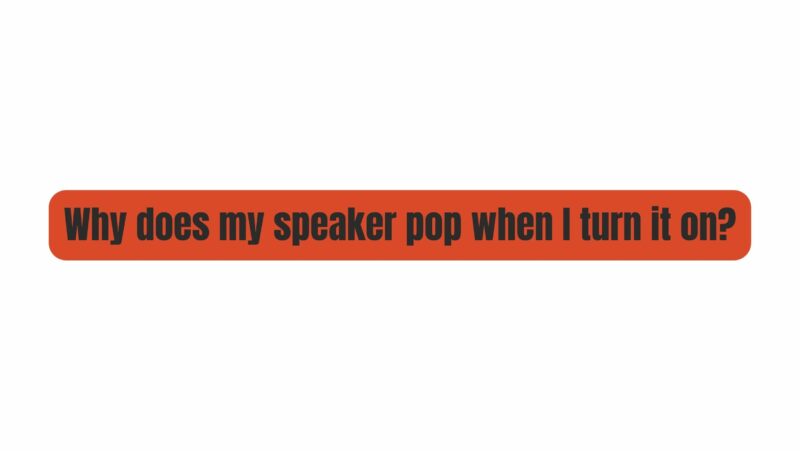Speakers are the auditory windows to our world of entertainment, faithfully translating electrical signals into the beautiful sound that fills our rooms. However, as we power up our audio systems, many of us have experienced an unexpected disruption: a distinct popping sound. This phenomenon can be disconcerting and raise questions about the health of our speakers. In this comprehensive article, we will unravel the mysteries behind why speakers pop when powered on, explore the potential consequences for audio quality, and discuss effective strategies to address and prevent this phenomenon.
Understanding the Popping Sound
Before delving into the causes of speaker popping, it’s essential to have a basic understanding of how speakers operate. A speaker is essentially a transducer that converts electrical signals (audio signals) into mechanical vibrations (sound waves). This transformation process relies on several key components, including a diaphragm, voice coil, and magnet.
Now, let’s explore the common factors that contribute to the popping sound when speakers are turned on:
1. Amplifier and Capacitor Discharge
One of the primary culprits behind speaker popping is the discharge of the amplifier and capacitors within the audio system. When you power on your audio system, the amplifier begins sending electrical signals to the speaker. If the amplifier has been in a standby or low-power state, capacitors within it can accumulate a charge. When the amplifier suddenly activates to send a signal to the speaker, this discharge can lead to a pop.
2. DC Offset
Another factor that can contribute to popping sounds is the presence of a DC offset. DC offset occurs when there is a small, residual direct current (DC) present in the audio signal. This offset can result from various factors, including imperfections in the audio source or amplifier circuitry. When the speaker is powered on, it can amplify this DC offset, leading to a popping sound.
3. Inrush Current
When you turn on your speaker, it can result in a sudden rush of electrical current, particularly in amplifiers. This is known as inrush current. The rapid flow of current can create a transient electrical disturbance, leading to a popping sound. Properly managing inrush current is crucial to minimizing this effect.
4. Impedance Mismatch
Impedance mismatch can also contribute to popping sounds. This occurs when there is a mismatch between the speaker’s impedance and the amplifier’s output impedance. This discrepancy can cause variations in current and voltage, resulting in pops and potentially damaging the speaker.
5. Mechanical Factors
In some instances, mechanical issues within the speaker itself can contribute to popping sounds. These issues may include loose components, damaged diaphragms, or worn-out voice coils. Mechanical problems require physical inspection and maintenance to address.
Impact on Audio Quality
While the popping sound itself might appear to be a minor annoyance, it can have various implications for audio quality:
- Audio Distortion: The pop can be loud enough to cause distortion in the audio playback, detracting from the overall listening experience.
- Potential Speaker Damage: Repeated and severe popping can lead to wear and tear on the speaker’s components, potentially resulting in reduced sound quality or even catastrophic speaker failure.
- Disruption to Listening Experience: The popping sound can be distracting, especially during quiet or delicate audio moments in music or movies.
Preventing and Addressing Speaker Popping
Fortunately, there are several effective strategies to prevent or address the popping sound when turning on your speakers:
1. Utilize a Delayed Power-On Sequence
Many modern audio systems feature a delayed power-on sequence. This sequence gradually increases power to the speaker, minimizing or eliminating the pop when the system is turned on. Ensure that this feature is enabled in your equipment settings.
2. Deploy a Power Conditioner
Power conditioners are valuable accessories that help stabilize the electrical supply to your audio equipment. They reduce the likelihood of pops and other unwanted noises by providing clean and consistent power.
3. Check for DC Offset
If you suspect a DC offset issue, it’s advisable to consult with a professional audio technician. They can diagnose and correct the problem within your audio system, ensuring that the audio signal is free from DC offset.
4. Implement Soft Start or Inrush Current Limiting
Invest in audio equipment that incorporates soft start or inrush current limiting features. These features help manage the initial surge of electrical current when the system is powered on, reducing the impact of inrush current and minimizing pops.
5. Verify Proper Impedance Matching
Ensure that your speakers and amplifier are correctly matched in terms of impedance. This harmonious matching helps prevent voltage and current fluctuations that can lead to popping sounds.
6. Perform Regular Maintenance
Regularly inspect and maintain your speakers to detect and address any mechanical issues. This includes checking for loose components, assessing the condition of diaphragms, and monitoring the health of voice coils. Prompt maintenance can prevent mechanical factors from causing popping sounds.
Conclusion
In conclusion, the popping sound when turning on your speakers, though seemingly trivial, can be an unwelcome disruption in your auditory experience. By understanding the factors contributing to this phenomenon and implementing the appropriate strategies, you can ensure that your audio system operates smoothly and without any disruptive noises. Whether you rely on delayed power-on sequences, power conditioners, or soft start features, these solutions are readily available to elevate your auditory experience. By taking these steps, you can enjoy the world of sound without the intrusive pops that sometimes accompany it.
In summary, addressing speaker popping when turning on involves a combination of technological solutions and regular maintenance. These measures include delayed power-on sequences, power conditioners, addressing DC offset issues, utilizing soft start or inrush current limiting, confirming proper impedance matching, and conducting routine speaker maintenance. With these strategies at your disposal, you can relish your audio experiences without the irksome popping sounds that can detract from the listening experience.

